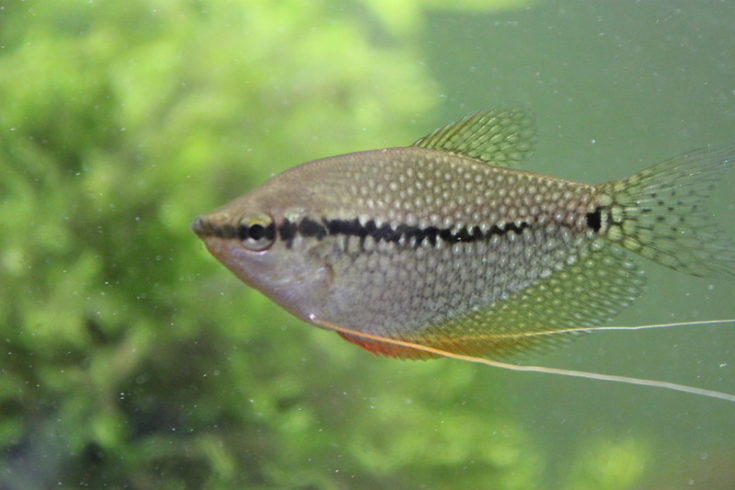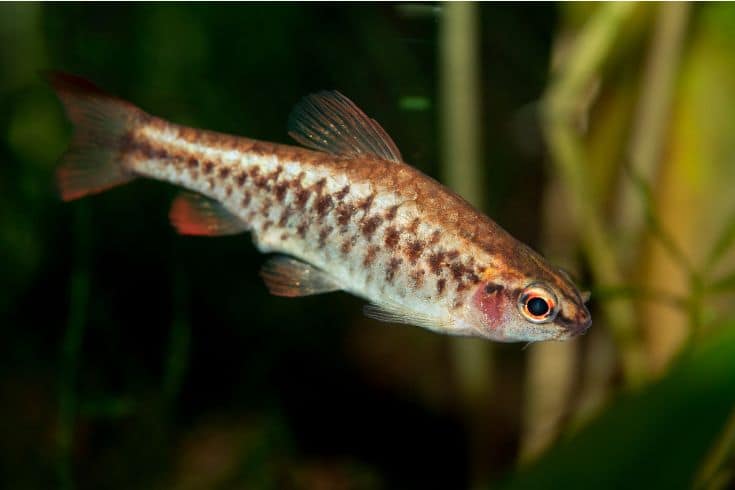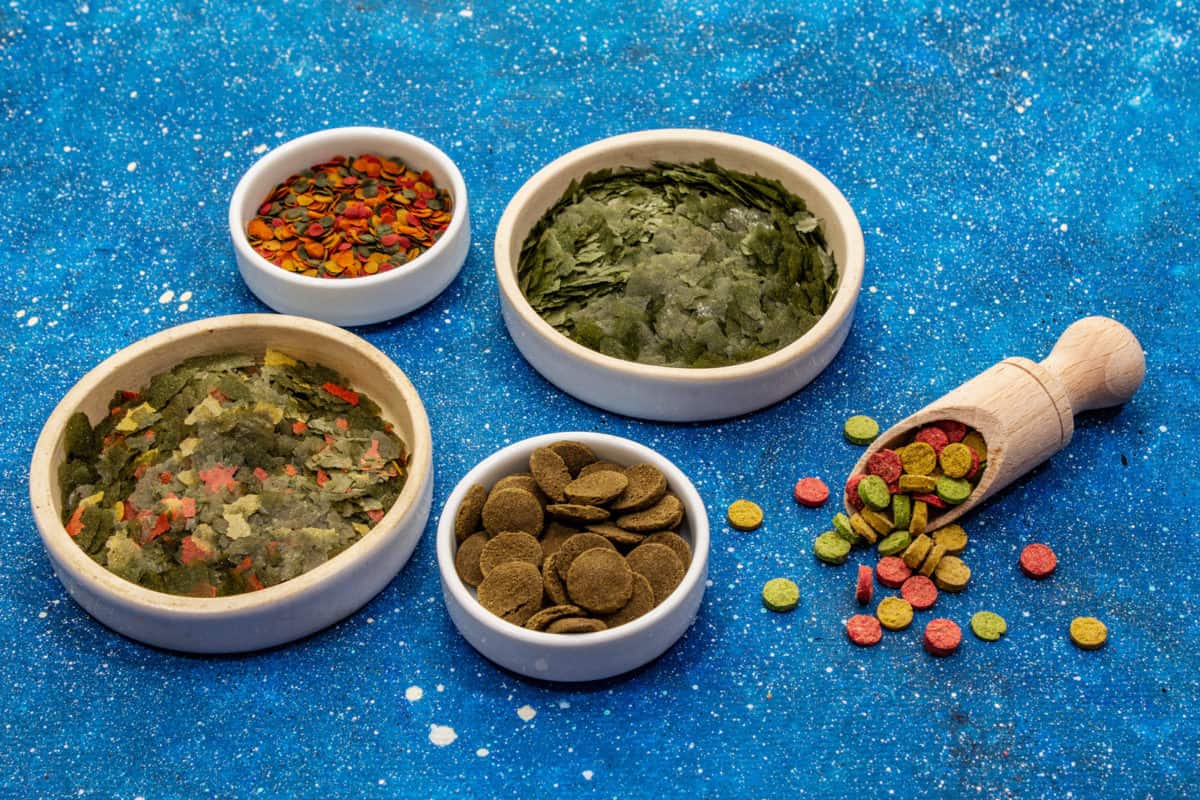The Pearl gourami is a beautiful tropical aquarium fish that’s hardy and beginner-friendly. You can buy these fish from good fish stores and online for a modest outlay.
But how big do Pearl gouramis get? Are Pearl gouramis peaceful fish? And will gouramis eat other fish?
Read this comprehensive guide to learn how to care for these charming labyrinth fish.
Pearl Gourami – Overview
Scientific Name
Trichopodus leerii
Common Name (species)
Pearl gourami, Leeri gourami, Mosaic gourami, Diamond gourami, Lace gourami
Family
Osphronemidae
Origin
Thailand, Sumatra, Borneo, Malaysia
Diet
Omnivore
Care Level
Beginner-friendly
Activity
Active
Lifespan
4 to 5 years
Temperament
Peaceful community fish, but males can be territorial
Tank Level
Middle to upper regions of the water column
Minimum Tank Size
20 gallons
Temperature Range
Tropical 77° to 82° F
Water Hardness
2 – 30 dKH
pH Range
5.5 to 7.5
Filtration/Flow Rate
Prefers well-filtered water and a low flow rate
Breeding
Bubble nest builder, egg layer
Compatibility
Generally peaceful
OK, for Planted Tanks?
Yes
Origins and Natural Habitat
Pearl gouramis originate from Borneo, Sumatra, Thailand, and Malaysia, and there are a few introduced populations in Singapore and Colombia. These fish prefer the acidic conditions of lowland coastal swamps, where the water flow is low.
Pearl gouramis currently feature on the IUCN Red List of Threatened Species as “near threatened,” thanks to overfishing and habitat destruction. However, most of the specimens you find for sale in fish stores are captive-bred fish.
Appearance
Pearl gouramis are attractive fish that have long, thin feelers instead of traditional ventral fins.
These colorful fish are surface feeders and have small, upturned mouths.
The fish has a blue body that fades to brown decorated with tiny pearl-like flecks, which give the Pearl gourami its common name. There’s a black line extending along the body from the fish’s mouth to its tail, ending in a black spot.

Sexing Pearl Gourami
Male and female Pearl gouramis are pretty easy to tell apart.
Male fish are angular and thinner than females, which are plumper and rounder when in spawning conditions. Males are also more colorful than females, having brilliant red or orange-colored breasts and throats.
Male Pearl gouramis have dorsal fins that are longer and more pointed than females.
Size and Lifespan
The average Pearl gourami lifespan is between 4 and 5 years, growing to around 4.5 to 5 inches when fully grown.
Females are usually somewhat smaller than males.
Activity Level/Behavior
Pearl gouramis are quite active fish, swimming together in loose groups in the mid to upper levels of the water column. Occasionally, these labyrinth breathers visit the water’s surface to breathe gulps of air.
Male Pearl gouramis are rather territorial, although a large, well-decorated tank usually mitigates that.
Tank Mates
Pearl gouramis are beautiful freshwater fish that generally do well in a community setup with other peaceful fish of a similar size. That said, males can be territorial and can sometimes be aggressive toward conspecifics and other gourami species.

I’ve always found keeping several females and one male Pearl gourami together works pretty well.
Good companion fish for gouramis can be Cherry barbs, Neon tetras, danios, Corydoras catfish, and the like.
Feeding Your Pearl Gourami
Pearl gouramis are omnivorous, enjoying a varied diet of meat, plant matter, and veggies.
Types of Food to Feed Your Fish
Pearl gouramis are not fussy feeders and are pretty easy to cater to.
My gouramis did very well on a basic daily diet of high-quality tropical fish flakes, with some frozen meaty foods, such as blood worms, daphnia, and mosquito larvae, added to give variety.
Although gouramis love live foods, you must be extremely careful when sourcing them. The live foods you buy from fish stores sometimes include bacteria and parasites that you don’t want in your fish tank.
So, unless you have a safe, reliable source, it’s best to give your gouramis frozen meaty protein instead.
How Much Food Should You Give?
We recommend feeding your Pearl gouramis twice daily.

Offer your fish only what they will eat in a couple of minutes. That prevents overfeeding, which can cause digestive problems and leads to uneaten food rotting in the tank and polluting the water.
Habitat Requirements
Pearl gouramis are a peaceful species that are undemanding, tolerating a wide range of water conditions.
That said, the water quality in your tank should be pristine, as these fish won’t cope with poor water quality.
Tank Size
Gouramis are quite large, active fish that need a rectangular 20-gallon tank. These fish can jump, so your aquarium must have a cover slide or lid.
Water Movement and Filtration
Pearl gouramis prefer well-filtered water with a low flow.
We recommend an external filtration system, preferably with an adjustable outlet valve. Alternatively, simply use decorations and plants to buffer and deflect the flow away from your fish.
Temperature and pH Level
Pearl gouramis are tropical fish that require a water temperature of between 77° and 82° F.
Note: The ambient room temperature must be close to the water temperature to prevent damage to the fish’s delicate labyrinth organ.

Pearl gouramis prefer soft, slightly acidic water with a pH of 5.5 to 7.5 and a hardness of 2 to 30 dH.
Tank Setup, Substrate, and Decorations
As with all fish species, your Pearl gouramis will settle in better if you can replicate the conditions of their wild habitat.
Lighting
So, in the wild environment, Pearl gouramis inhabit dimly lit water. If you have an LED lighting unit with a special effect setting, you can alter the brightness or do what I did and use floating plants to provide dappled shade for the habitat.
Substrate
A dark substrate shows off your gouramis’ colors to the best effect. You can use a gravel or sandy substrate that provides a good anchoring point for your living plants.
Driftwood and twisted roots are nice natural decorations that can help to lower the water’s pH by releasing tannic and gallic acid into the water. You might also want to include some smooth rocks and pebbles and plenty of plants.
However, Pearl gouramis are active swimmers, so be sure to leave plenty of open swimming space for them.
Setting Up Your Pearl Gourami Tank
Assemble everything you need to set up your tank:
- Dark-colored substrate
- LED lighting unit
- Filter
- Heater
- Aquarium thermometer
- Decorations
- Living plants
How to Set Up Your Fish Tank:
- Wash the substrate to get rid of dust.
- Add a couple of inches of the clean substrate to your tank.
- Install the filter and heater units, but don’t switch them on yet.
- Fill your tank with dechlorinated tap water. Add some fish food or a couple of drops of pure ammonia to start the nitrogen cycle.
- Pour the water over an upturned bowl in the center of the substrate to prevent the gravel from being displaced.
- Wash decorations to remove dust, and put them in your aquarium.
- Snip off damaged plant stems and dead leaves, and put the plants in your tank, leaving adequate space between them for growth and spread.
- Activate the filter and heater.
Test the aquarium water every day for the next few weeks until ammonia and nitrites are zero and nitrates are around 20 ppm. Now you can add a few small fish!
Health and Disease
Pearl gouramis are pretty hardy, healthy fish, although they can suffer from a few common fish diseases.
Signs of Good Health
Healthy Pearl gouramis swim in groups in the upper areas of the water column, visiting the water surface every so often to breathe atmospheric air through their labyrinth organ.
Red Flags
These red flags indicate health problems in your Pearl gouramis:
- Loss of appetite
- Inactivity
- Hanging at the water’s surface
- Red patches, swellings, ulcers, and fading color
- Flashing or rubbing against solid objects in the aquarium
Common Health Issues and Treatment
Health Issue
Ich (White Spot Disease)
Symptoms or Causes
Ich is a very common disease that’s caused by an aquatic protozoan parasite.
Fish infected with Ich develop a sprinkling of tiny white spots on their fins, gill covers, and bodies. They also flash against the gravel and other solid objects in the aquarium.
Suggested Action
Raise the water temperature to 82o F for three days. Use an OTC White Spot Disease medication to treat the tank.
Health Issue
Flukes
Symptoms or Causes
Flukes is the term used to describe various types of external fish parasites. These macroparasites can often be seen with the naked eye attached to the fish’s skin or gills.
Suggested Action
Treat the fish tank with an OTC antiparasitic medication.
Health Issue
Fungal infections
Symptoms or Causes
White fluffy growths on the fish’s body, mouth, and head.
Suggested Action
Quarantine infected fish, and treat with an antifungal medication.
Health Issue
Bacterial infections
Symptoms or Causes
Sores and ulcers on the body and head, ragged, bloody fins.
Suggested Action
Treat the tank with OTC antibacterial treatment.
How To Breed Pearl Gouramis
You can breed Pearl gouramis at home in a separate breeding tank.
To give your fish the best chance of breeding successfully, feed them plenty of meaty protein for a couple of weeks.
Spawning Tank
Your spawning tank should have lots of aquarium plants and a water temperature of around 80o F.
The water in the breeding tank should be around six inches deep, enabling the fry to get to the surface so that the labyrinth organ develops correctly.
Spawning
Male Pearl gouramis build bubble nests at the water’s surface, typically in a corner or under a raft of floating plants.
Once the female has laid 200-300 eggs, the pair transfer the eggs to the nest. At this stage, it’s safest to remove the female, as the male goes into guarding mode, and he might attack his mate.
After the eggs hatch, the fry remains attached to the egg sac for a couple of days. We recommend removing the male now, as he might eat the fry once they become free-swimming.
Raising Fry
Feed the growing fry on liquid fry food and infusoria several times daily until they are large enough to eat finely crushed fish flake and baby brine shrimp.
It’s essential to perform partial water changes every few days to keep the water clean. If the water is dirty, the fry won’t survive.
Availability
Pearl gouramis are readily available in most good pet stores and online, retailing for a few dollars per fish.
Final Thoughts
Did you enjoy our guide to Pearl gouramis? If you did, please share the article!
Pearl gouramis are a beautiful species of community fish that are easy to care for and relatively hardy, provided you give them the correct living conditions and a varied, high-quality omnivore diet.
Although these fish are suitable for beginner aquarists, male gouramis can be territorial, so it’s best to keep one male with a few females, an arrangement that can also make a fun breeding program.
What tank mates work with your Pearl gouramis? Tell us in the comments box below.